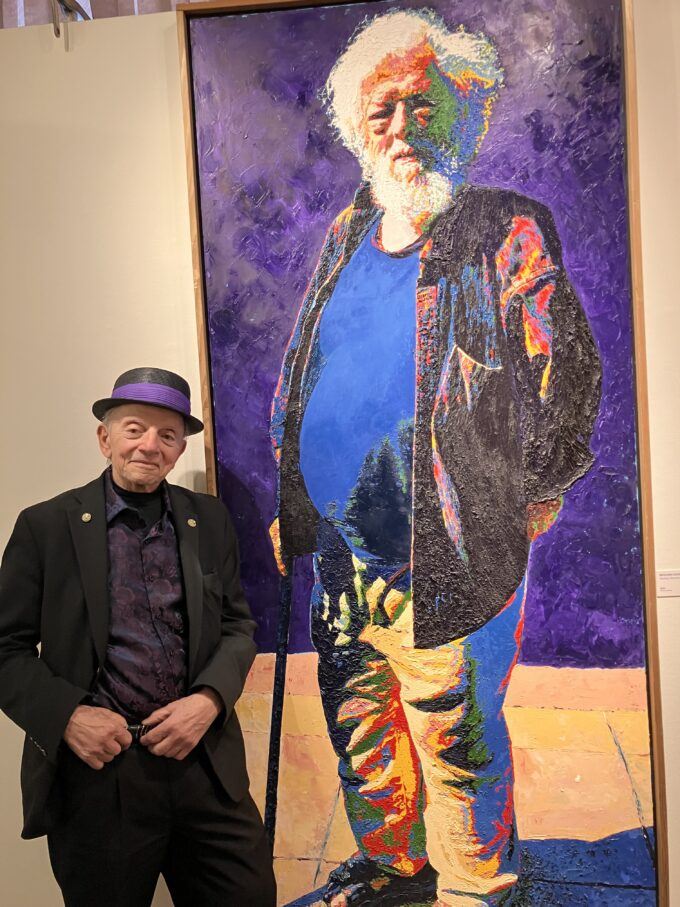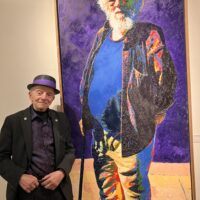






























































Richard (Luckey) Perri portrait of Sterling Bunnell. Photo: Jonah Raskin.
Think of San Francisco artists and you’re likely to think of Ruth Asawa, whose work is currently on exhibit at SFMOMA, and Wayne Thieibaud, who had his first show in SF in 1960 and whose work is now at the Legion of Honor. To those artists add the name Richard (“Luckey”) Perry, whose colorful paintings are on the walls of the Italo Americano Museo in a show curated by Bianca Friundi, who recently told a crowd,“We’re proud to have Perri’s work here and to have him in person.”
The exhibit opened February 8, 2025 and runs until June 7, 2025. Wearing black trousers, a black jacket and a pork pie hat, Perri stood in front of his painting of Coit Tower on Telegraph Hill and talked for an hour about art and The City where he has lived and worked for decades.
Perri loves Italy; his father came from Sicily and his mother from Calabria. He holds dual citizenship: Italian and American. He might one day be forced to leave the US and go to Italy. It’s no secret that Perri also loves San Francisco. So no one was shocked when he told the audience at the Italo Americano Museo in Fort Mason, “I love this city.”
Perri doesn’t love all of the city’s 46.9 square miles.
He loves a particular slice of San Francisco that is vanishing but that hasn’t entirely disappeared. Perri loves the old San Francisco that once had a thriving waterfront, ships in the harbor, longshoremen and cafes like “Red’s Java House” at 38 Bryant that was founded during the Depression of the 1930s and that is still serving its signature sausage sandwiches on Mondays and the ever popular corn beef and hash on Saturdays and Sundays. “I express my attachment to this place through my paintings,” Perri says. “There’s a lot of freedom here.”
No one has captured in color the urban face of old San Francisco more faithfully than Perri and that’s no accident. For years he owned and operated a bar at Mission and 29th Street where the regulars were, he says, characters out of the pages of Damon Runyan and had names like “Gorilla Dog,” “Indian Dave” and “Baldy Ray.” In their company, Perri acquired the nickname “Luckey.”
The Italo Americano Museo in Fort Mason’s Building C is exhibiting more than two dozen of his iconic canvases of landmark places like Red’s Java House and City Lights Bookstore on Columbus Avenue, plus San Francisco personalities like Gavin Newsom, and the poet, publisher, and painter Lawrence Ferlinghetti, as well as Sterling Bunnell, the Bay Area psychiatrist whose patients included a great many artists and writers.
Perri isn’t as well known as many of the places, such as Coit Tower, he has captured on canvases, and not as famous as some of the people, including ex mayor and now Governor Newsom, whose portraits he has painted. But neither is he a complete unknown. Over the decades he’s acquired a small devoted following.
Call him the peoples’ painter. Granted, he doesn’t paint workers or working class neighborhoods but he paints the places where workers have eaten and the streetcars that they’ve taken to and from employment. Perri’s studio on the second floor of the Odd Fellows Building on Seventh Street near Market, isn’t located in a neighborhood that’s a destination for tourists and foodies. Call it an outdoor living room for members of the lumpenproletariat.
Perri doesn’t have an agent and he’s not connected to a gallery, which enables him, he says, “to paint whatever I want to paint.” Not a single canvas exhibited at the Italo-Americano Museum has a price tag. “I’m not trying to sell my work,”Perri says. “And I’m not thinking about living a long life. I’m thinking about painting.” He adds, “But if you want to buy one of my canvases we can talk.” A quotation from Perri on a wall painted white reads, “I have more ideas and images in my mind than I have seconds in my life.” At the age of 81, he’s still painting, still tapping into his creative energy. Years ago, during a bout with depression, Sterling Bunnell provided a dose of much needed talk therapy, but mostly Perri’s art has kept him feeling good about himself and the world. He’s been a lucky man.
Perri was born to a blue collar Catholic family; his father came from Sicily, his mother from Calabria. His father worked for the railroad and was injured on the job, an experience that his son has long remembered. Working class life could be precarious. Perri grew up in Rockville Center on Long Island, before the coming of Levittown, the suburban housing development.
He got out of Long Island as fast as he could, left the church and went west, attended college in Santa Fe, New Mexico and in Tempe, Arizona before enrolling at the San Francisco Art Institute. “I arrived with flowers in my hair,” he says. He joined the underground comic scene, met and worked with Art Spiegelman long before Spiegelman mined his father’s concentration experience and created the Maus comic books with Jews as mice and Nazis as cats. Spiegelman made art from the darkest of material.
Perri’s paintings might, on a first take, look realistic, but they’re not, especially not the colors. “They all express a certain mood,” Perri says. A journalist named Julie Zigoris noted that his paintings express both loneliness and a sense of nostalgia. That sounds about right, though one might also say that working class people are an invisible, palpable presence. The immense skies in Perri’s work have no matching colors that one might see and recognize in the skies above Russian Hill or Golden Gate Park, and his street cars look far more psychedelic than any streetcars that operate on Market Street.
The Dutch artist, Vincent van Gogh, famous for his sun flowers, blue skies and wheat fields with crows, has inspired some of Perri’s best work. “The application of the paint is the important thing,” he says. What he’s after is called “luminosity,” which he defines as the “spirituality of something that is gone.” Indeed, his art captures the luminosity of San Francisco. The word, luminosity, also provides the title of his book for sale at the Italo Americano Museo.
The post San Francisco’s Inimitable Artist, Richard “Luckey” Perri appeared first on CounterPunch.org.
This post was originally published on CounterPunch.org.